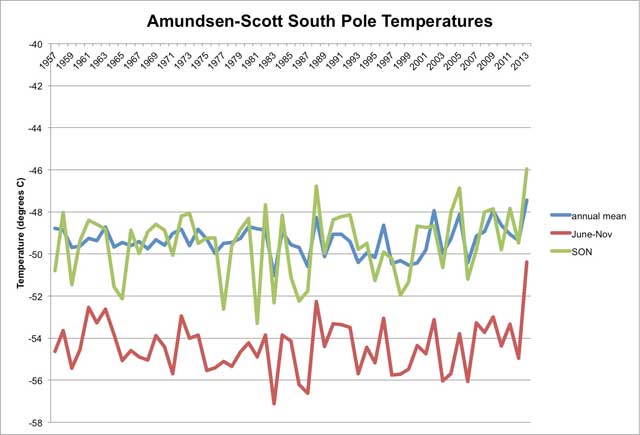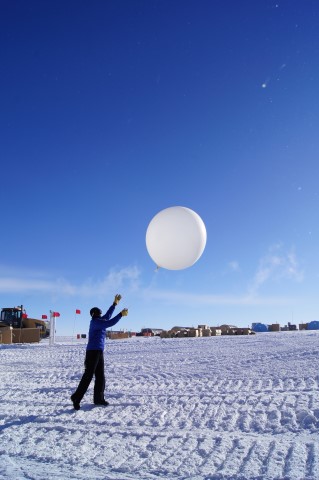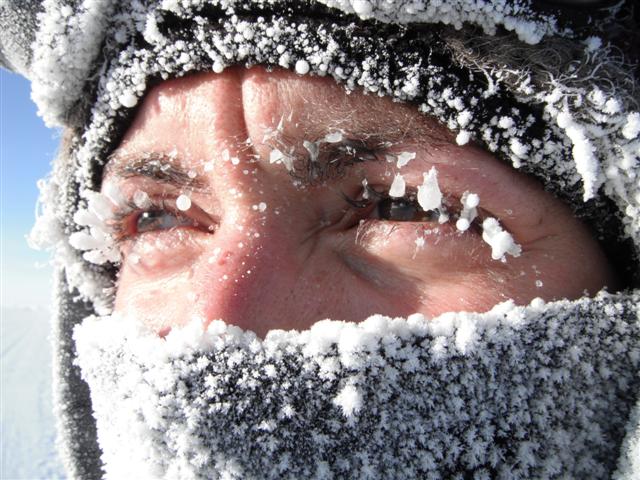Record highSouth Pole experienced warmest year ever in 2013, while sea ice continued to expandPosted August 15, 2014
A warm winter at the Amundsen-Scott South Pole Station The annually averaged temperature of minus 47.4 degrees Celsius in 2013 was a half-degree centigrade higher than the next warmest year, recorded in both 2009 and 2002, at minus 47.9C. Record-keeping at South Pole began in 1957 with the establishment of the first research station there by the United States. The first year-round measurements began in 1958. The finding was one of many eye-opening climate statistics to come out of the annual State of the Climate report 
Graphic credit: Ryan Fogt
Temperature trends at the South Pole show a spike through the period of June through November 2013.
The main editors for the chapter on Antarctica were Ryan Fogt at Ohio University The report uses dozens of climate indicators to track patterns, changes, and trends of the global climate system, including greenhouse gases; temperatures throughout the atmosphere, ocean, and land; cloud cover; sea level; ocean salinity; sea ice extent; and snow cover. The sum total of the indicators continued to reflect trends of a warmer planet, according to a NOAA press release Major greenhouse gas concentrations, including carbon dioxide (CO2), methane and nitrous oxide, continued to rise during 2013, once again reaching historic high values, according to the report, published in the Bulletin of the American Meteorological Society. CO2 concentrations reached a global average of 395.3 parts per million in 2013. The daily concentration of CO2 at the Mauna Loa Observatory In addition, 2013 was among the warmest years on record, ranking between second and sixth depending upon one of four major datasets used. In the Southern Hemisphere, Australia experienced its warmest year on record, while Argentina had its second warmest and New Zealand its third warmest. It was also a record-breaking year for Antarctic climate, due to weaker winds surrounding Antarctica that allowed for more warm air to intrude from the north, even to the interior of the Antarctic continent, according to Fogt, an associate professor at Ohio University and director of the Scalia Laboratory for Atmospheric Analysis Coupled with above-average air pressure, the warm air was sinking more than normal over the continent. As air sinks, it warms by compression, Fogt explained. 
Photo Credit: Elaine Hood/Antarctic Photo Library
South Pole meteorologist Philip Marzette launches a weather balloon in 2013.
“Normally winds are fairly strong around Antarctica, which locks the cold air in over the continent,” he said by e-mail. “When these winds weaken, more warm air can get in – and cold air can get farther north, sort of like the U.S. experienced with outbreaks this past winter of the polar vortex.” New monthly average records were set at the South Pole in both August and September, with a new record maximum temperature of minus 27.7C recorded during the latter month. In August, the record average temperature of minus 53.3C broke the previous record of minus 53.6C set in August 1996. The departure from normal was 6.4 degrees Celsius. The record average max temperature of minus 49.0C broke the previous record of minus 49.6C, also set in August 1996. The average temperature of minus 51.2C in September 2013 broke the previous highest average temperature for the month of minus 52.6C set in 2005. In addition, the average maximum temperature of minus 47.5C broke the previous highest average maximum temperature of minus 48.5C, also set in 2005. June 2013 also came close to a monthly record. It tied for the third warmest June since 1957, with an average of minus 52.7C, the warmest it has been for the month of June since 2007. That was 5.8 degrees Celsius above normal. In addition, the all-time maximum temperature record for the month of June was set not once but twice. On June 2, the wintertime temperature hit minus 30.1C, shattering the previous record of 37.6C set in 1987. The new June record barely lasted two weeks. On June 19, the temperature climbed to minus 28.8C. 
Photo Credit: Kristina 'Kricket' Scheerer/Antarctic Photo Library
Despite last year's record warm temperatures, the South Pole remains one of the coldest places on the planet.
It’s been less than three years since the maximum temperature ever recorded at the South Pole also fell. The temperature officially hit minus 12.3 degrees Celsius about 3:50 p.m. on Dec. 25, 2011. That broke the old record of minus 13.6C set on Dec. 27, 1978 – though technically that record had been broken on Christmas Eve, Dec. 24, 2011, when the temperature climbed to minus 13.3C. [See previous article — Heat wave: South Pole hits record high temperature on Christmas Day.] So far, the 2014 winter hasn’t seen many records fall, according to Stephanie Olcott, lead meteorologist at South Pole Station. However, the months of April, May and June have all been about 3.2 to 3.6 degrees Celsius above monthly averages, she said. The average annual temperature at the South Pole is about minus 49.4C. In the summer, from late October to early February, the average is closer to minus 32C. Fogt said that while a warming trend appears to be emerging at the South Pole, it is still not statistically significant. “The only places where significant warming is uniformly observed is across West Antarctica and the Antarctic Peninsula, but this is seasonally dependent,” he noted. “More modeling work needs to happen before we can say for certain whether or not patterns like the ones observed in 2013 will occur in response to greenhouse gas emissions or other forcing mechanisms,” he added. |



For USAP Participants |
For The Public |
For Researchers and EducatorsContact UsNational Science FoundationOffice of Polar Programs Geosciences Directorate 2415 Eisenhower Avenue, Suite W7100 Alexandria, VA 22314 Sign up for the NSF Office of Polar Programs newsletter and events. Feedback Form |

